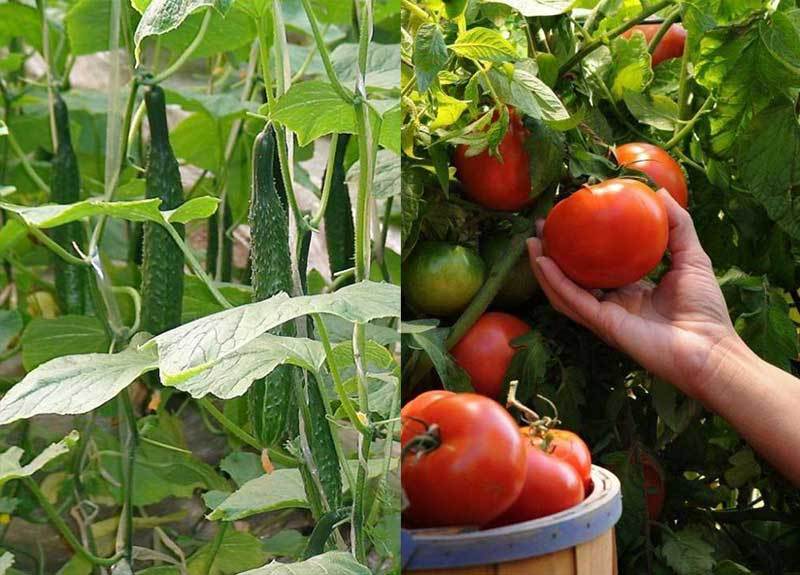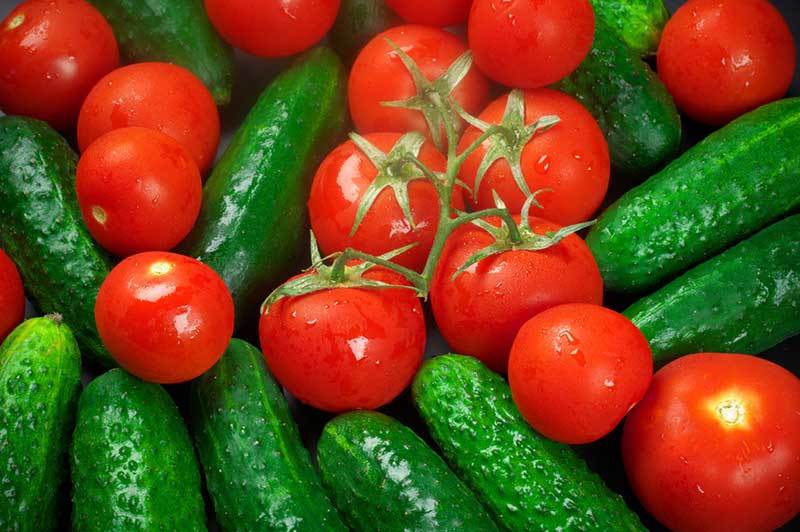Can You Plant Tomatoes and Cucumbers Together?
Introduction
Companion planting can maximize your garden’s potential. But you should never pair some certain plants together. Because they may cause the growth issues of the plants. Cucumbers and tomatoes are a prime example.
You should take the time to plan and research your garden’s layout. You must understand the risks of this combination. You can produce the best possible harvest. You will enjoy successful harvests season after season.
Understanding Companion Planting
The concept: Companion planting is an important concept in gardening. They will benefit each other in various ways when you grow two or more plants together. For example, providing shade and nutrients for one another and even deterring pests.
The advantages: Companion planting has multiple benefits. For example, reducing pest infestations, providing support and shade for other plants, improving soil fertility, and promoting better air flow. However, there are also some disadvantages to improper pairings. For example, when you plant cucumbers next to tomatoes.
Can You Plant Cucumbers and Tomatoes Together?
The benefits of this combination: They can create a mutually beneficial environment when planting cucumbers and tomatoes together. You may successfully grow tomatoes and cucumbers together if you take certain measures.
Plant them in separate rows and far enough apart. So they do not compete for resources or become more prone to pests. You can use loamy or sandy soils with pH level 5.8-7.0. Additionally, you should add some organic material such as compost or manure. The plants will have nutrients for healthy growth.
The potential consequences: You may find success in tomato and cucumber companion planting. But doing so carries potential risks. When planting tomatoes with cucumbers, they will compete for essential nutrients in the soil or on the roots of each other’s plant. They may stunt growth and reduce yields.
If one plant is diseased or creates an environment hospitable for pests, it could spread to the other crop and cause further damage. Before growing tomatoes and cucumbers together, you should first check the climate of your area. Tomatoes need full sun exposure while cucumbers prefer partial shade. Both crops may not get the light they need if you plant cucumbers and tomatoes together.

Disease and Pest Management
Cucumber and tomato are the popular vegetables. They are susceptible to some diseases and pests. You should learn about common pests and diseases. This protects your garden from potential damage. This is an important aspect of successful vegetable gardening.
Common Diseases: Cucumber mosaic virus is one of the most common diseases. Symptoms include yellow mottling on cucumber leaves, distorted fruits and stunted growth in plants. Alternaria leaf spot affects both cucumbers and tomatoes. It is a fungal disease that starts as dark spots on the leaves. Alternaria leaf spots can eventually spread to the fruit.
Tomatoes are particularly susceptible to bacterial speck and blight, both of which are caused by bacteria. Bacterial speck causes dark spots on tomato fruits while bacterial blight causes spots and streaks on the foliage. Late blight is another fungal disease. It will cause yellow spotting or brown patches on tomato fruits and leaves.
Common Pests: Aphids are one of the most common pests that affect cucumber plants. They suck plant sap from stems and leaves. They can cause distorted growth in plants and discoloration of leaves or flowers.
Tomato hornworms are another common pest. It will eat the leaves of both cucumbers and tomatoes. You can identify them by horn-like protrusion on their backs and their green coloration with white stripes.
Whitefly is a major pest for both cucumbers and tomatoes. These tiny insects cause yellowing of leaves, distortion of fruits and wilting of plants.
Can cucumbers and tomatoes be planted together? Growing tomatoes and cucumbers together can increase the risk of infection or infestation from either one plant to the other. Planting cucumbers and tomatoes together can encourage the spread of diseases from one plant to the other.
They have similar environmental conditions and a shared pest/disease pool. For example, if either crop is infected with Alternaria leaf spot, spores will be carried by air currents or moved via physical contact between plants. Eventually infecting both crops.
Certain pests may feed on both cucumbers and tomatoes simultaneously when you plant them together. For example, aphids or tomato hornworms. This increases the likelihood of pest infestation. Pests will further spread throughout the entire garden.
Companion plants for cucumbers and tomatoes
Companion plants for tomatoes: Many companion plants can promote tomatoes healthier growth. For example, marigolds, garlic, chives or calendula. Marigolds contain Pyrethrum and can repel some insects like whiteflies and aphids. Calendula’s strong scent can keep pests like aphids away from tomato plants.
Garlic has properties that naturally protect against soil borne diseases. It also helps prevent root rot and other fungal problems. Chives can act as a natural pest repellant but additionally help attract pollinators such as bees and butterflies.
Companion plants for cucumbers: Cucumbers have some companion planting, including radishes, nasturtiums and squash. Radish will attract beneficial insects. They help control pest populations in the garden. It also provides shade for cucumber vines even on hot days.
Nasturtiums act as a natural insecticide.. Squash provides a living barrier between them and pests to protect cucumbers. They also provide helpful nutrients through their roots to nourish cucumber plants.
Tips for well-rounded garden layout: Tomatoes and cucumbers don’t always make good companions. Because they are susceptible to similar pests and diseases. Fortunately, you can plant many alternatives near tomatoes for better results.
You should plan a well-rounded garden layout for optimal growth and health. You can plant vegetables, herbs and flowers together in your garden space. The diverse ecosystem will keep pests at bay.
Additionally, make sure each individual plant has enough room to grow. So they can reach their full potential without competing for resources. Keep in mind when you plan out your garden this season for the best results!
Best Practices for Tomato and Cucumber Gardening
Tips for growing healthy plants: Tomatoes and cucumbers have different growing needs. To enjoy a successful harvest, you should take into account their individual preferences for soil, spacing, watering and fertilization.
Can cucumbers and tomatoes share a trellis? When planting tomatoes and cucumbers separately, proper spacing is key. You should give tomato plants enough space to spread out. You can plant in rows about 24 inches apart. This can provide more exposure to sunlight and better air circulation. Cucumber plants should be spaced at least 18 inches apart with staking or trellising. It depends on the type of variety.
How often should you water cucumbers and tomatoes? When watering tomatoes, you should keep soil moist but not over-saturated. Aim for about 1-2 inches of water per week. Cucumbers require more water than tomatoes. You should water 1-2 times per day during hot summer months. The soil will keep moist and reduce disease or stress on the plants.
How often should you fertilize tomatoes and cucumbers? You can add organic compost to feed their roots. For an extra boost, consider applying a slow-release fertilizer once every 6 weeks for both vegetables. You should follow directions carefully when using any type of fertilizer. Because too much can burn roots and stunt growth.
The importance of crop rotation: Don't grow the same plant in the same spot year after year. Because the nutrients of the soil will be depleted. This will lead to a decrease in vegetable production. To help preserve soil health for both tomatoes and cucumbers, be sure to rotate your plants every season or two. Then, each area isn’t being over-utilized.

FAQs About Planting Cucumbers Near Tomatoes
What should not be planted next to tomatoes?
Tomatoes are susceptible to certain pests and diseases. So you should avoid planting them close to other crops that may carry these ailments. It’s best to avoid planting cucumbers, peppers, eggplants, potatoes, melons, squash or even beans near tomatoes.
These vegetables share the same pests and diseases. These easily spread from one plant to another if they are grown too closely together. You should keep some distance between tomato varieties.
What should you not plant next to cucumbers?
Cucumbers are also prone to diseases. They are especially susceptible to bacterial wilt. You should keep them away from other plants. This prevents the spread of this infection. Because they may carry bacteria, such as potatoes and melons.
Corn should also be avoided when growing cucumbers. Because it can easily smother or shade them out in the garden. Additionally, different varieties of cucumber plants should have adequate spacing between each other. Avoid planting tomatoes next to cucumbers. Because some of the same pests and diseases will affect them.
Can you grow tomatoes peppers and cucumbers together?
You can grow cucumbers, peppers and tomatoes together. You should keep in mind the different needs of each vegetable when planning your garden layout. Tomatoes require more sun than peppers and cucumbers. So you should plant them in a sunny location. Cucumbers and peppers thrive in areas with partial shade or indirect sunlight.
Additionally, you should space these plants out. So that their vines don't overlap too much. Because this could lead to disease spreading between them. With proper spacing and adequate sunlight for each plant species, tomatoes, peppers and cucumbers can happily grow alongside one another in your garden!
Are coffee grounds good for tomato and cucumber plants?
You can use coffee grounds as a fertilizer. The coffee grounds are high in nitrogen, potassium and phosphorus. When added directly to the soil, coffee grounds act as an organic mulch. They will retain moisture and suppress weeds.
Be sure to monitor the pH level of your soil when adding coffee grounds, in case it becomes too acidic for the plants you’re growing. In some cases, simply watering down areas where coffee grounds have been added will help keep the soil at a proper pH balance.
Can zucchini and cucumbers be planted together?
It's not recommended to plant zucchini and cucumber together. The two crops share the same family. They can suffer from the same diseases if planted too close to each other. Keep them separated from one another at least a few feet. This prevents the spread of disease and maintains healthy plants.
Additionally, zucchini can quickly overtake cucumber plants if planted too close, resulting in smaller and poorer-quality yields. For these reasons, it’s best to plant zucchini and cucumbers in separate areas of the garden or allot a larger space for each crop individually.
Conclusion
Can you grow tomatoes and cucumbers together? Growing cucumbers next to tomatoes has devastating consequences. The two vegetables have the same diseases and pests. They may spread quickly if you plant tomatoes and cucumbers next to each other. This can lead to poor harvests or complete crop loss.
You can use several strategies to plant cucumbers and tomatoes together. For example, create adequate separation between the two vegetables. Apart from cucumber vines at least three feet away from any tomato plant.
Companion planting improves the soil quality, reduces pest infestation and boosts yields. For instance, planting dill next to cucumbers can improve their flavor. Rotating crops regularly can maintain good soil health and prevent disease from spreading.


